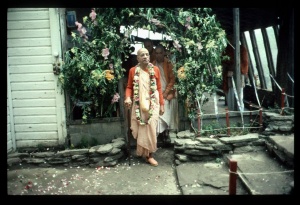SB 11.16.30: Difference between revisions
m (1 revision(s)) |
(Vanibot #0054 edit - transform synonyms into clickable links, which search similar occurrences) |
||
| (One intermediate revision by one other user not shown) | |||
| Line 1: | Line 1: | ||
{{info | {{info | ||
|speaker=Lord | |speaker=Lord Kṛṣṇa the Supreme Personality of Godhead | ||
|listener=Uddhava | |listener=Uddhava | ||
}} | }} | ||
[[Category:Srimad-Bhagavatam - Canto 11 Chapter 16]] | |||
[[Category:Bhagavatam Verses Spoken by Lord Krsna - Vanisource|111630]] | |||
<div style="float:left">'''[[Srimad-Bhagavatam]] - [[SB 11|Eleventh Canto]] - [[SB 11.16: The Lord's Opulence|Chapter 16: The Lord's Opulence]]'''</div> | |||
<div style="float:right">[[File:Go-previous.png|link=SB 11.16.29]] '''[[SB 11.16.29]] - [[SB 11.16.31]]''' [[File:Go-next.png|link=SB 11.16.31]]</div> | |||
{{RandomImage}} | |||
{{SBnotice}} | |||
==== TEXT 30 ==== | ==== TEXT 30 ==== | ||
<div | <div class="verse"> | ||
ratnānāṁ padma-rāgo 'smi | :ratnānāṁ padma-rāgo 'smi | ||
padma-kośaḥ su-peśasām | :padma-kośaḥ su-peśasām | ||
kuśo 'smi darbha-jātīnāṁ | :kuśo 'smi darbha-jātīnāṁ | ||
gavyam ājyaṁ haviḥṣv aham | :gavyam ājyaṁ haviḥṣv aham | ||
</div> | </div> | ||
| Line 17: | Line 22: | ||
==== SYNONYMS ==== | ==== SYNONYMS ==== | ||
<div | <div class="synonyms"> | ||
''[//vanipedia.org/wiki/Special:VaniSearch?s=ratnānām&tab=syno_o&ds=1 ratnānām]'' — of jewels; ''[//vanipedia.org/wiki/Special:VaniSearch?s=padma&tab=syno_o&ds=1 padma]-[//vanipedia.org/wiki/Special:VaniSearch?s=rāgaḥ&tab=syno_o&ds=1 rāgaḥ]'' — the ruby; ''[//vanipedia.org/wiki/Special:VaniSearch?s=asmi&tab=syno_o&ds=1 asmi]'' — I am; ''[//vanipedia.org/wiki/Special:VaniSearch?s=padma&tab=syno_o&ds=1 padma]-[//vanipedia.org/wiki/Special:VaniSearch?s=kośaḥ&tab=syno_o&ds=1 kośaḥ]'' — the lotus cup; ''[//vanipedia.org/wiki/Special:VaniSearch?s=su&tab=syno_o&ds=1 su]-[//vanipedia.org/wiki/Special:VaniSearch?s=peśasām&tab=syno_o&ds=1 peśasām]'' — among beautiful things; ''[//vanipedia.org/wiki/Special:VaniSearch?s=kuśaḥ&tab=syno_o&ds=1 kuśaḥ]'' — the sacred kuśa grass; ''[//vanipedia.org/wiki/Special:VaniSearch?s=asmi&tab=syno_o&ds=1 asmi]'' — I am; ''[//vanipedia.org/wiki/Special:VaniSearch?s=darbha&tab=syno_o&ds=1 darbha]-[//vanipedia.org/wiki/Special:VaniSearch?s=jātīnām&tab=syno_o&ds=1 jātīnām]'' — among all types of grass; ''[//vanipedia.org/wiki/Special:VaniSearch?s=gavyam&tab=syno_o&ds=1 gavyam]'' — cow products; ''[//vanipedia.org/wiki/Special:VaniSearch?s=ājyam&tab=syno_o&ds=1 ājyam]'' — offering of ghee; ''[//vanipedia.org/wiki/Special:VaniSearch?s=haviḥṣu&tab=syno_o&ds=1 haviḥṣu]'' — among oblations; ''[//vanipedia.org/wiki/Special:VaniSearch?s=aham&tab=syno_o&ds=1 aham]'' — I am. | |||
</div> | </div> | ||
{{SBcollapse}} | |||
==== TRANSLATION ==== | ==== TRANSLATION ==== | ||
<div | <div class="translation"> | ||
Among jewels I am the ruby, and among beautiful things I am the lotus cup. Among all types of grass I am the sacred kuśa, and of oblations I am ghee and other ingredients obtained from the cow. | Among jewels I am the ruby, and among beautiful things I am the lotus cup. Among all types of grass I am the sacred kuśa, and of oblations I am ghee and other ingredients obtained from the cow. | ||
</div> | </div> | ||
| Line 31: | Line 36: | ||
==== PURPORT ==== | ==== PURPORT ==== | ||
<div | <div class="purport"> | ||
Pañca-gavya refers to five sacrificial ingredients obtained from the cow, namely milk, ghee, yogurt, dung and urine. The cow is so valuable that even its dung and urine are antiseptic and fit for sacrificial offering. Kuśa grass is also used for religious occasions. Mahārāja Parīkṣit constructed a sitting place from kuśa grass during the last week of his life. Among beautiful things the lotus cup formed by lotus petals represents Lord Kṛṣṇa, and among jewels the ruby, which is similar to Lord Kṛṣṇa's own Kaustubha gem, symbolizes the potency of the Lord. | ''Pañca-gavya'' refers to five sacrificial ingredients obtained from the cow, namely milk, ghee, yogurt, dung and urine. The cow is so valuable that even its dung and urine are antiseptic and fit for sacrificial offering. ''Kuśa'' grass is also used for religious occasions. Mahārāja Parīkṣit constructed a sitting place from ''kuśa'' grass during the last week of his life. Among beautiful things the lotus cup formed by lotus petals represents Lord Kṛṣṇa, and among jewels the ruby, which is similar to Lord Kṛṣṇa's own Kaustubha gem, symbolizes the potency of the Lord. | ||
</div> | </div> | ||
__NOTOC__ | </div> | ||
</div> | |||
<div style="float:right">[[File:Go-previous.png|link=SB 11.16.29]] '''[[SB 11.16.29]] - [[SB 11.16.31]]''' [[File:Go-next.png|link=SB 11.16.31]]</div> | |||
__NOTOC__ | |||
__NOEDITSECTION__ | |||
Latest revision as of 20:24, 17 February 2024

A.C. Bhaktivedanta Swami Prabhupada
Please note: The synonyms, translation and purport of this verse were composed by disciples of Śrīla Prabhupāda
TEXT 30
- ratnānāṁ padma-rāgo 'smi
- padma-kośaḥ su-peśasām
- kuśo 'smi darbha-jātīnāṁ
- gavyam ājyaṁ haviḥṣv aham
SYNONYMS
ratnānām — of jewels; padma-rāgaḥ — the ruby; asmi — I am; padma-kośaḥ — the lotus cup; su-peśasām — among beautiful things; kuśaḥ — the sacred kuśa grass; asmi — I am; darbha-jātīnām — among all types of grass; gavyam — cow products; ājyam — offering of ghee; haviḥṣu — among oblations; aham — I am.
Translation and purport composed by disciples of Śrīla Prabhupāda
TRANSLATION
Among jewels I am the ruby, and among beautiful things I am the lotus cup. Among all types of grass I am the sacred kuśa, and of oblations I am ghee and other ingredients obtained from the cow.
PURPORT
Pañca-gavya refers to five sacrificial ingredients obtained from the cow, namely milk, ghee, yogurt, dung and urine. The cow is so valuable that even its dung and urine are antiseptic and fit for sacrificial offering. Kuśa grass is also used for religious occasions. Mahārāja Parīkṣit constructed a sitting place from kuśa grass during the last week of his life. Among beautiful things the lotus cup formed by lotus petals represents Lord Kṛṣṇa, and among jewels the ruby, which is similar to Lord Kṛṣṇa's own Kaustubha gem, symbolizes the potency of the Lord.